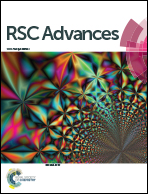Enhanced hydrogen production by photofermentative microbial aggregation induced by l-cysteine: the effect of substrate concentration, C/N ratio and agitation rate
Abstract
Continuous biomass washout from photobioreactors resulting from the poor flocculation of photofermentative bacteria (PFB) diverts electron flux away from hydrogen production to continuing biosynthesis. This work showed that three key parameters, the substrate concentration, C/N ratio and agitation rate significantly influenced the flocculation behavior of Rhodopseudomonas faecalis RLD-53. Excessive substrate (75 mmol l−1) led an apparent drop in the flocculability, while a proper content of extracellular polymeric substances (EPS) at a C/N ratio of 10 : 2 was beneficial to aggregation of R. faecalis RLD-53. Control of the appropriate agitation rate not only enhanced EPS production and aggregation of PFB, but also avoided disruption of PFB aggregation caused by intensive hydrodynamic shear forces generated from excessive agitation. The optimal flocculability (47.67%) of R. faecalis RLD-53 was obtained at a substrate concentration of 50 mmol l−1, C/N ratio of 10 : 2 and agitation rate of 80 rpm. In the entire continuous operation, most PFB aggregates accumulated in the photobioreactor with only 0.55 g of biomass washout, much less than 2.86 g from free cell culture. Consequently, the maximum hydrogen yield of 2.57 mol H2 per mol acetate and production rate of 706 ml l−1 d−1 were obtained by PFB aggregates, as biomass synthesis was greatly reduced. Therefore, aggregation of PFB is a promising strategy to mediate the reductant away from biomass synthesis into hydrogen production in continuous operation.


 Please wait while we load your content...
Please wait while we load your content...